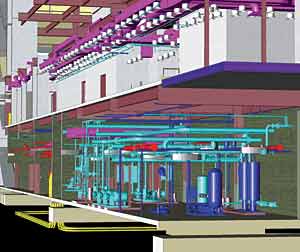The goal of SmithGroup, a firm with 800 architects, is to
be modeling all of its projects in 3-D in 2006. The firm has
implemented BIM on a number of key pilot projects throughout
the United States, including a corporate pharmaceutical lab
facility in the Detroit area, the new headquarters of general
contractor Sundt Construction in Tempe, Ariz., and an expansion
of Comer Children's Hospital in Chicago. The Comer project,
due to be completed in Spring 2006, is the Chicago office's
ninth BIM project, the first to integrate the architecture
with the structural steel frame and the mechanical and electrical
systems. "BIM is so important for where we're going,"
says principal Jens Mammen, leader of the Chicago office's
BIM transition. "Strategically, BIM is on the verge of
revolutionizing how we deliver our projects. We don't
draw buildings any more, we build buildings."

In the design of
Chicago's Comer Children's Hospital
expansion, A/E firm SmithGroup integrated
the architectural design with the structural
steel frame and mechanical and electrical
systems.
Rendering credit:
SmithGroup |
|
|
The true value of an integrated BIM project is realized downstream,
during the design and construction process. Collision detection
and coordination of the project with design and construction
team members is where BIM benefits the SmithGroup financially
and saves costs on the project, says Mammen. "Fifty percent
of coordination is about the 2-D drawing itself," he
says. "With the 3-D model, the project is so well coordinated
and built so quickly that we're receiving very few questions
from the field, especially during the bidding process."
On the Comer project, the firm received only six RFIs in
the bidding process, an astoundingly low number compared to
the hundreds that would typically be received. For Mammen,
the benefits attainable through BIM are too great to ignore:
"I can't foresee ever going back to the 2-D world."
|
How BIM Benefits Architects
|
|
Building Information Modeling
offers architects the following advantages:
- Enhanced influence
over the entire life of the project:
BIM enables architects to be the primary shaper
of the built environment. Over time, architects
have seen their influence upon building projects
erode as project progress toward completion.
BIM gives architects a greater capability to
see their designs through to project completion.
The BIM process gives architects the power to
estimate costs in real time, keeping projects
on schedule, avoiding the necessity for last-minute
changes, and reducing project scope as the only
means of addressing project cost overruns.
- Providing
a better solution to clients:As the
member of the building team with the earliest
contact and the closest relationship with the
owner, the architect has the opportunity to
enhance the firm's image as an industry
leader on the cutting edge of technology and
industry practice. Being an experienced BIM
practitioner separates a firm from the competition,
giving the architect a powerful way to bring
added value to the owner and their project.
Architects can demonstrate to owners how BIM
can be implemented to reduce project costs,
shorten project schedules, increase project
quality, and improve safety through information
sharing, emphasis on front-loaded design and
virtual building, and off-site fabrication of
building components. One of the maxims in the
construction world is that a project owner may
ask for cheaper, faster and better, but will
only be able to get two of the three. The evidence
from projects constructed utilizing a BIM methodology
indicates that it is possible to deliver completed
projects that are completed faster, are less
expensive, of higher quality, and with increased
project safety, and reduced exposure to risk
and litigation.
- Increased
profitability: Early collaboration with
the structural engineer, steel team, MEP consultants
and other specialty contractors leads to more
accurate and complete drawings the first time,
as well as efficient resolution of RFIs, and
fewer RFIs later in the project. This saves
time and money for the architect in that the
project proceeds more efficiently and quickly
to completion, allowing the firm to handle more
projects. Fewer, if any, change orders means
a reduction in the cost of those changes and
delays attributed to the architect.
- Reduced risk
and possibility of litigation: The integration
of the entire design team through the use of
3-D computer-aided design and construction technology
nurtures cooperation, trust, and team building,
which reduces risk instead of increases it.
Interferences are identified and resolved earlier
on in the design process, reducing the number
of issues that arise late in the project and
lessening the likelihood of litigation. With
BIM, it can truly be said that before construction
begins, an as-built model of the project exists.
- Preservation
and growth of the practice: BIM is an
important innovation and trend for the building
design and construction industry, and is increasingly
applied to large-scale, complex projects. Most
industry experts predict that in 10 years, 3-D-integrated
BIM will be the principal method in which the
built environment is designed and constructed.
Architects have the opportunity to step forward,
engage the process, and assume more responsibility
for their building designs. As much as a technological
change, the transition to BIM is a cultural
change, requiring a rethinking of how the design
and construction process can and should work.
|
|










